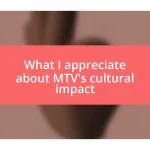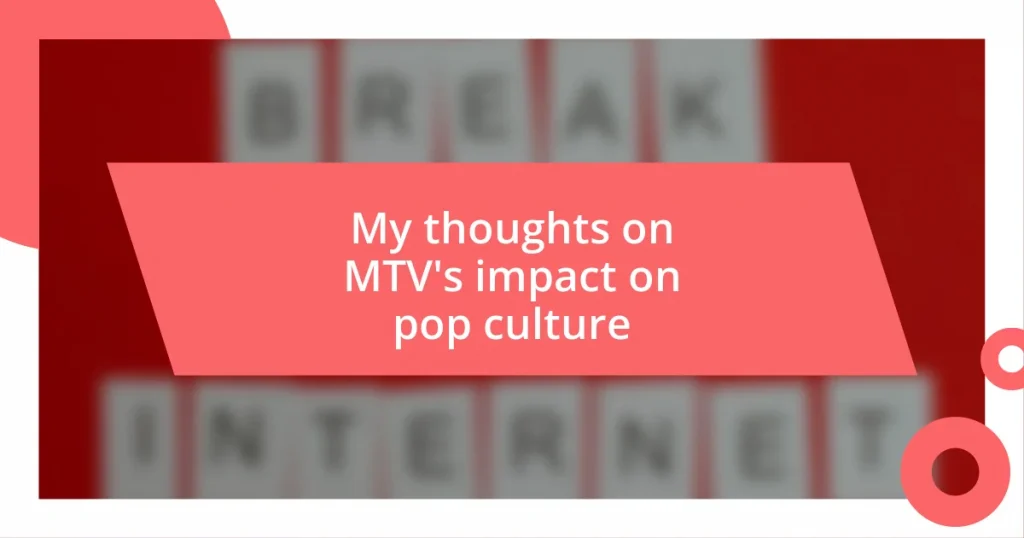Key takeaways:
- MTV revolutionized music consumption, creating a cultural phenomenon that integrated music with fashion, social commentary, and identity.
- It initiated profound cultural shifts, promoting diverse narratives, blending music genres, and encouraging youth activism through impactful shows.
- MTV reshaped artist branding, emphasizing the importance of visual identity, storytelling, and lifestyle representation in connecting artists with their audiences.

Introduction to MTV’s Influence
MTV revolutionized the way we consume music and entertainment, becoming a cultural phenomenon that shaped a generation. I remember eagerly waiting for the latest music video to drop, as it felt like an event—so much more than just a song. Did you experience that thrill too? It was like being part of an exclusive club that defined the music scene.
Through its innovative approach, MTV not only promoted songs but also created icons. Artists like Madonna and Michael Jackson didn’t just make music; they crafted visual statements that intertwined with their sound. I often reflect on how these videos conveyed powerful messages and pushed boundaries, leaving me both inspired and challenged in my perceptions of culture and identity.
MTV also impacted fashion, language, and social attitudes, influencing what was cool or controversial. I recall how watching “The Real World” ignited discussions among my friends about the portrayal of diverse lifestyles and social issues. It’s fascinating to consider how a channel dedicated to music became a mirror reflecting the complexities of society itself. Wouldn’t you agree that this tapestry of influence is what makes MTV a central thread in pop culture’s fabric?

Cultural Shifts Initiated by MTV
The cultural shifts initiated by MTV were profound and far-reaching. I vividly remember the first time I saw a music video that was more than just a performance—it was a full-fledged narrative. These videos transformed the way we viewed artists and their art. The emphasis on image and storytelling changed our expectations, pushing pop culture to new heights. Each video seemed to open a dialogue about race, gender, and societal norms, inviting us to examine our own beliefs.
- Fashion Evolution: MTV popularized trends like glam rock and hip-hop, leading audiences to embrace bold styles.
- Social Commentary: Shows like “Yo! MTV Raps” introduced diverse narratives, giving voice to underrepresented communities.
- The Rise of Icons: Artists became cultural figures—think of Madonna’s influence on feminism or Prince’s challenge to gender norms.
- Music Genre Blending: The fusion of genres showcased on MTV laid the groundwork for today’s eclectic soundscape.
- Youth Activism: MTV turned its platform into a force for social change, encouraging youth engagement through initiatives like Choose or Lose.
Reflecting on these changes, I often wonder how many conversations sparked among friends and families while we navigated the impact of these cultural shifts. Each video and show became a catalyst for exploration and debate in our homes, shaping our perspectives in ways I hadn’t initially realized.

MTV’s Role in Artist Branding
MTV has played a pivotal role in how artists cultivate their brand identities. I remember when I first saw Lady Gaga’s “Bad Romance” video—her unique visual aesthetic not only set her apart from other pop stars but also made me curious about her message and persona. This kind of strategic branding helped artists connect deeply with their audience, turning casual listeners into devoted fans.
Moreover, the importance of consistent visual branding became apparent as artists leveraged MTV’s platform to tell their stories. From the daring fashion choices to the evocative themes in their videos, artists learned that every aspect of their image mattered. I often think about how artists like Lil Nas X used his vibrant visuals and bold narratives to redefine what it means to be an artist today. Isn’t it fascinating how an artist’s choice of representation can spark conversations that ripple through pop culture?
As I reflect on MTV’s lasting impact, I can’t help but notice how its influence persists. The music video format has evolved with platforms like YouTube, but the core idea remains the same: artists are not just selling music; they’re selling a lifestyle and a narrative. It’s a beautiful, if complicated, dance between creativity and marketing—where every move is scrutinized and celebrated. Don’t you find it intriguing how this blend of art and branding has changed the way we perceive individuals in the music industry?














